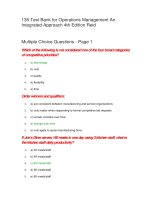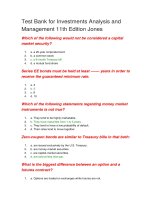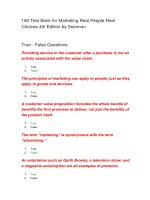Test bank for data analysis and decision making 4th edition albright
Bạn đang xem bản rút gọn của tài liệu. Xem và tải ngay bản đầy đủ của tài liệu tại đây (58.53 KB, 4 trang )
Full file at />
CHAPTER 1: Introduction to Data Analysis and Decision Making
MULTIPLE CHOICE
1. The decision-making concepts covered in Data Analysis & Decision Making book include which of
the following?
a. Optimization techniques
c. Structured sensitivity analysis
b. Decision analysis with uncertainty
d. All of these options
ANS: D
PTS: 1
MSC: AACSB: Analytic
2. Which of the following statements is not true?
a. Dealing with uncertainty includes measuring uncertainty
b. Dealing with uncertainty includes modeling uncertainty explicitly into the analysis.
c. Dealing with uncertainty includes eliminating uncertainty by using the normal probability
distribution
d. Uncertainty is a key aspect of most business problems, and dealing with uncertainty
requires a basic understanding of probability
ANS: C
PTS: 1
MSC: AACSB: Analytic
3. Which of the following is not one of the important themes of your Data Analysis & Decision Making
book?
a. Data analysis
c. Decision making
b. Dealing with uncertainty
d. Data mining
ANS: D
PTS: 1
4. Data analysis includes
a. data description
b. data inference
MSC: AACSB: Analytic
c. the search for relationships in data
d. All of these options
ANS: D
PTS: 1
MSC: AACSB: Analytic
5. Which of the following is not one of the steps in the modeling process?
a. Select scale for model
b. Collect and summarize data
c. Verify the model
d. Present the results
e. Implement the model and update it through time
ANS: A
PTS: 1
MSC: AACSB: Analytic
6. Which of the following would not be included under data analysis?
a. Measuring uncertainty
c. Data inference
b. Data description
d. Search for relationships
ANS: A
PTS: 1
MSC: AACSB: Analytic
7. The decision making process includes
a. optimization techniques for problems with no uncertainty
b. decision analysis for problems with uncertainty
c. sensitivity analysis
d. All of the above
ANS: D
PTS: 1
MSC: AACSB: Analytic
8. Which of the following is not one of the types of models described in Data Analysis & Decision
Making book?
a. Algebraic model
c. Scale model
b. Spreadsheet model
d. Graphical model
buy this full document at
Full file at />
ANS: C
PTS: 1
MSC: AACSB: Analytic
9. The modeling process discussed in Data Analysis & Decision Making book is a
a. seven-step process
b. six-step process
c. five-step process
d. four-step process
e. three-step process
ANS: A
PTS: 1
MSC: AACSB: Analytic
10. Which of the following is Excel add-in for performing what-if analyses?
a. PrecisionTree
b. TopRank
c. Solver
d. @Risk
e. StatTools
ANS: B
PTS: 1
MSC: AACSB: Analytic
11. Which of the following statements are false?
a. The modeling process discussed in Data Analysis & Decision Making book is five- step
process
b. Dealing with uncertainty requires a basic understanding of probability
c. Uncertainty is a key aspect of most business problems
d. Data description and data inference are included under data analysis
ANS: A
PTS: 1
MSC: AACSB: Analytic
12. Which of the following statements are false?
a. Decision-making includes optimization techniques for problems with certainty, decision
analysis for problems with certainty, and structured sensitivity analysis.
b. Graphical models can be very helpful for simple problems. For complex problems,
however, graphical models usually fail to show the important elements of a problem and
how they are related.
c. Dealing with uncertainty includes measuring uncertainty and modeling uncertainty
explicitly into the analysis.
d. All of these options
ANS: C
PTS: 1
MSC: AACSB: Analytic
13. Which of the following statements are true:
a. A fairly recent alternative to algebraic modeling is spreadsheet modeling. Instead of
relating various quantities with algebraic equations and inequalities, we relate them in a
spreadsheet with cell formulas.
b. Data are usually meaningless until they are analyzed for trends, patterns, relationships, and
other useful information
c. Algebraic models, by means of algebraic equations and inequalities, specify a set of
relationships in a very precise way. Their main drawback is that they require an ability to
work with abstract mathematical symbols.
d. When we make inferences from data and search for relationships in data, or when we use
decision trees to help make decisions, we must deal with uncertainty.
e. All of these options
ANS: E
PTS: 1
MSC: AACSB: Analytic
14. Which of the following statements are true?
a. Three important themes run through the book. Two of them are in the title: data analysis
and decision making. The third is dealing with uncertainty.
buy this full document at
Full file at />
b. Data analysis includes data description, data inference, and the search for relationships in
data
c. Decision making includes optimization techniques for problems with no uncertainty,
decision analysis for problems with uncertainty, and structured sensitivity analysis.
d. Dealing with uncertainty includes measuring uncertainty and modeling uncertainty
explicitly into the analysis.
e. All of these options
ANS: E
PTS: 1
MSC: AACSB: Analytic
15. Which of the following is an Excel add-in for simulation?
a. PrecisionTree
b. TopRank
c. Solver
d. @Risk
e. StatTools
ANS: D
PTS: 1
MSC: AACSB: Analytic
TRUE/FALSE
1. Data analysis includes data description, data inference, and the search for relationships in data.
ANS: T
PTS: 1
MSC: AACSB: Analytic
2. Decision-making includes optimization techniques for problems with certainty, decision analysis for
problems with certainty, and structured sensitivity analysis.
ANS: F
PTS: 1
MSC: AACSB: Analytic
3. Dealing with uncertainty includes measuring uncertainty and modeling uncertainty explicitly into the
analysis.
ANS: F
PTS: 1
MSC: AACSB: Analytic
4. The authors of Data Analysis & Decision Making book described three types of models: graphical
models, algebraic models, and spreadsheet models.
ANS: T
PTS: 1
MSC: AACSB: Analytic
5. Graphical models are the least intuitive type of model. Its purpose is simply to provide enough
quantitative details to enable us solve the problem of interest.
ANS: F
PTS: 1
MSC: AACSB: Analytic
6. Three important themes run through this book: data analysis, decision-making, and dealing with
uncertainty.
ANS: T
PTS: 1
MSC: AACSB: Analytic
7. Graphical models can be very helpful for simple problems. For complex problems, however, graphical
models usually fail to show the important elements of a problem and how they are related.
ANS: F
PTS: 1
MSC: AACSB: Analytic
8. The overall modeling process typically done in the business world always require seven steps: define
the problem, collect and summarize data, formulate a model, verify the model, select one or more
suitable decisions, present the results to the organization, and finally implement the model and update
it through time.
ANS: F
PTS: 1
MSC: AACSB: Analytic
9. Algebraic models, by means of algebraic equations and inequalities, specify a set of relationships in a
very precise way. Their main drawback is that they require an ability to work with abstract
mathematical symbols.
ANS: T
PTS: 1
MSC: AACSB: Analytic
10. Data are usually meaningless until they are analyzed for trends, patterns, relationships, and other
useful information.
ANS: T
PTS: 1
MSC: AACSB: Analytic
buy this full document at
Full file at />
11. A fairly recent alternative to algebraic modeling is spreadsheet modeling. Instead of relating various
quantities with algebraic equations and inequalities, we relate them in a spreadsheet with cell formulas.
ANS: T
PTS: 1
MSC: AACSB: Analytic
12. When we use simulation models to help make decisions, we do not deal with uncertainty at all, since
we often must make inferences from the simulated data.
ANS: F
PTS: 1
MSC: AACSB: Analytic
13. When we make inferences from data and search for relationships in data, or when we use decision
trees to help make decisions, we must deal with uncertainty.
ANS: T
PTS: 1
MSC: AACSB: Analytic
14. The @Risk is Excel add-in that can be used to run replications of a simulation, keep track of outputs,
create useful charts, and perform sensitivity analyses.
ANS: T
PTS: 1
MSC: AACSB: Analytic
15. Graphical models are probably the least intuitive and most quantitative type of model.
ANS: F
PTS: 1
MSC: AACSB: Analytic
buy this full document at









